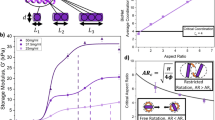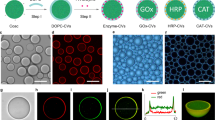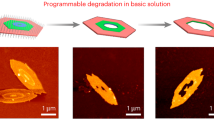Abstract
Efforts to create platelet-like structures for the augmentation of haemostasis have focused solely on recapitulating aspects of platelet adhesion1; more complex platelet behaviours such as clot contraction2 are assumed to be inaccessible to synthetic systems. Here, we report the creation of fully synthetic platelet-like particles (PLPs) that augment clotting in vitro under physiological flow conditions and achieve wound-triggered haemostasis and decreased bleeding times in vivo in a traumatic injury model. PLPs were synthesized by combining highly deformable microgel particles with molecular-recognition motifs identified through directed evolution. In vitro and in silico analyses demonstrate that PLPs actively collapse fibrin networks, an emergent behaviour that mimics in vivo clot contraction. Mechanistically, clot collapse is intimately linked to the unique deformability and affinity of PLPs for fibrin fibres, as evidenced by dissipative particle dynamics simulations. Our findings should inform the future design of a broader class of dynamic, biosynthetic composite materials.
This is a preview of subscription content, access via your institution
Access options
Subscribe to this journal
Receive 12 print issues and online access
$259.00 per year
only $21.58 per issue
Buy this article
- Purchase on Springer Link
- Instant access to full article PDF
Prices may be subject to local taxes which are calculated during checkout




Similar content being viewed by others
References
Modery-Pawlowski, C. L. et al. Approaches to synthetic platelet analogs. Biomaterials 34, 526–541 (2013).
Clemetson, K. J. Platelets and primary haemostasis. Thrombosis Res. 129, 220–224 (2012).
Evans, J. A. et al. Epidemiology of traumatic deaths: Comprehensive population-based assessment. World J. Surg. 34, 158–163 (2010).
McGwin, G. Jr et al. Reassessment of the tri-modal mortality distribution in the presence of a regional trauma system. J. Trauma 66, 526–530 (2009).
Geeraedts, L. M. Jr, Kaasjager, H. A., van Vugt, A. B. & Frolke, J. P. Exsanguination in trauma: A review of diagnostics and treatment options. Injury 40, 11–20 (2009).
Granville-Chapman, J., Jacobs, N. & Midwinter, M. J. Pre-hospital haemostatic dressings: A systematic review. Injury 42, 447–459 (2011).
Fries, D. & Martini, W. Z. Role of fibrinogen in trauma-induced coagulopathy. Br. J. Anaesth. 105, 116–121 (2010).
Gao, J. F. & Frisken, B. J. Cross-linker-free N-isopropylacrylamide gel nanospheres. Langmuir 19, 5212–5216 (2003).
Hendrickson, G. R. & Lyon, L. A. Microgel translocation through pores under confinement. Angew. Chem. Int. Ed. 49, 2193–2197 (2010).
Raut, S. & Gaffney, P. J. Evaluation of the fibrin binding profile of two anti-fibrin monoclonal antibodies. Thromb. Haemost. 76, 56–64 (1996).
Kolodziej, A. F. et al. Fibrin specific peptides derived by phage display: Characterization of peptides and conjugates for imaging. Bioconjug. Chem. 23, 548–556 (2012).
Scheefers-Borchel, U., Muller-Berghaus, G., Fuhge, P., Eberle, R. & Heimburger, N. Discrimination between fibrin and fibrinogen by a monoclonal antibody against a synthetic peptide. Proc. Natl Acad. Sci. USA 82, 7091–7095 (1985).
Lee, C. M., Iorno, N., Sierro, F. & Christ, D. Selection of human antibody fragments by phage display. Nature Protoc. 2, 3001–3008 (2007).
Myers, D. R. et al. Endothelialized microfluidics for studying microvascular interactions in hematologic diseases. J. Vis. Exp. 64, e3958 (2012).
Guzzetta, N. A. et al. The impact of aprotinin on postoperative renal dysfunction in neonates undergoing cardiopulmonary bypass: A retrospective analysis. Anesth. Analg. 108, 448–455 (2009).
Thomas, S. G., Calaminus, S. D., Auger, J. M., Watson, S. P. & Machesky, L. M. Studies on the actin-binding protein HS1 in platelets. BMC Cell Biol. 8, 46 (2007).
Suzuki-Inoue, K. et al. Involvement of Src kinases and PLCγ2 in clot retraction. Thromb. Res. 120, 251–258 (2007).
Jackson, S. P., Nesbitt, W. S. & Westein, E. Dynamics of platelet thrombus formation. J. Thromb. Haemost. 7 (suppl. 1), 17–20 (2009).
Masoud, H. & Alexeev, A. Controlled release of nanoparticles and macromolecules from responsive microgel capsules. ACS Nano 6, 212–219 (2012).
Bertram, J. P. et al. Intravenous hemostat: Nanotechnology to halt bleeding. Sci. Transl. Med. 1, 11ra22 (2009).
Fuglsang, J. et al. Platelet activity and in vivo arterial thrombus formation in rats with mild hyperhomocysteinaemia. Blood Coagul. Fibrinolysis 13, 683–689 (2002).
Ersoy, G. et al. Hemostatic effects of microporous polysaccharide hemosphere in a rat model with severe femoral artery bleeding. Adv. Therapy 24, 485–492 (2007).
Okano, T., Bae, Y. H. & Kim, S. W. in In Modulated Control Release System (ed Kost, J.) 17–46 (CRC Press, 1990).
Tsuchida, E. & Abe, K. Advances in Polymer Science Vol. 45, 1–119 (Springer, 1982).
Shibayama, M. & Tanaka, T. in Responsive Gels: Volume Transitions 1 Vol. 109 (ed Dusek, K.) 1–62 (Springer, 1993).
Alvarado, J., Sheinman, M., Sharma, A., MacKintosh, F. & Koenderink, G. Molecular motors robustly drive active gels to a critically connected state. Nature Phys. 9, 591–597 (2013).
Tsai, M. et al. In vitro modeling of the microvascular occlusion and thrombosis that occur in hematologic diseases using microfluidic technology. J. Clin. Invest. 122, 408–418 (2012).
Groot, R. D. & Warren, P. B. Dissipative particle dynamics: Bridging the gap between atomistic and mesoscopic simulation. J. Chem. Phys. 107, 4423–4435 (1997).
Hoogerbrugge, P. J. & Koelman, J. M. V. A. Simulating microscopic hydrodynamic phenomena with dissipative particle dynamics. Europhys. Lett. 19, 155–160 (1992).
Espanol, P. & Warren, P. Statistical-mechanics of dissipative particle dynamics. Europhys. Lett. 30, 191–196 (1995).
Acknowledgements
The authors wish to thank L. Tucker and S. Pitrowski Lees for assistance with in vivo studies, A. Winburn for assistance with particle synthesis, Z. Meng for AFM images of ULC μgels films, and Y. Sakuri, Y. Qui and D. Myers for assistance with platelet-poor plasma isolation. Funding sources: NIH (HHSN268201000043C, R21EB013743 and R01EB011566), John and Mary Brock Discovery Research Fund, and DoD (W81XWH1110306) to T.H.B.; NIH (R21EB013743) and DoD (W81XWH1110306) to L.A.L.; American Heart Association Postdoctoral Fellowship to A.C.B.; NSF GRF to V.S.; NSF CAREER Award (DMR-1255288) to A.A.; NIH (R01HL121264, U54 HL11230 and NSF CAREER Award (1150235) to W.A.L.
Author information
Authors and Affiliations
Contributions
A.C.B., S.E.S. and B.A., experimental design, data analysis and manuscript; R.T.H., K.S.D., E.S.H. and V.S., experimental design and data analysis; A.A., simulations, data analysis and manuscript; N.G., W.A.L., L.A.L. and T.H.B., experimental design and manuscript.
Corresponding authors
Ethics declarations
Competing interests
The authors declare no competing financial interests.
Supplementary information
Supplementary Information
Supplementary Information (PDF 4765 kb)
Supplementary Movie 1
Supplementary Movie 1 (AVI 1889 kb)
Supplementary Movie 2
Supplementary Movie 2 (AVI 1142 kb)
Supplementary Movie 3
Supplementary Movie 3 (AVI 3105 kb)
Supplementary Movie 4
Supplementary Movie 4 (AVI 1746 kb)
Supplementary Movie 5
Supplementary Movie 5 (AVI 3402 kb)
Supplementary Movie 6
Supplementary Movie 6 (MOV 6166 kb)
Supplementary Movie 7
Supplementary Movie 7 (MOV 6361 kb)
Rights and permissions
About this article
Cite this article
Brown, A., Stabenfeldt, S., Ahn, B. et al. Ultrasoft microgels displaying emergent platelet-like behaviours. Nature Mater 13, 1108–1114 (2014). https://doi.org/10.1038/nmat4066
Received:
Accepted:
Published:
Issue Date:
DOI: https://doi.org/10.1038/nmat4066
This article is cited by
-
Cargo-free particles divert neutrophil-platelet aggregates to reduce thromboinflammation
Nature Communications (2023)
-
Platelet-rich plasma: a comparative and economical therapy for wound healing and tissue regeneration
Cell and Tissue Banking (2023)
-
Engineered Molecular Therapeutics Targeting Fibrin and the Coagulation System: a Biophysical Perspective
Biophysical Reviews (2022)
-
Haemostatic materials for wound healing applications
Nature Reviews Chemistry (2021)
-
Microfluidic models of the human circulatory system: versatile platforms for exploring mechanobiology and disease modeling
Biophysical Reviews (2021)



